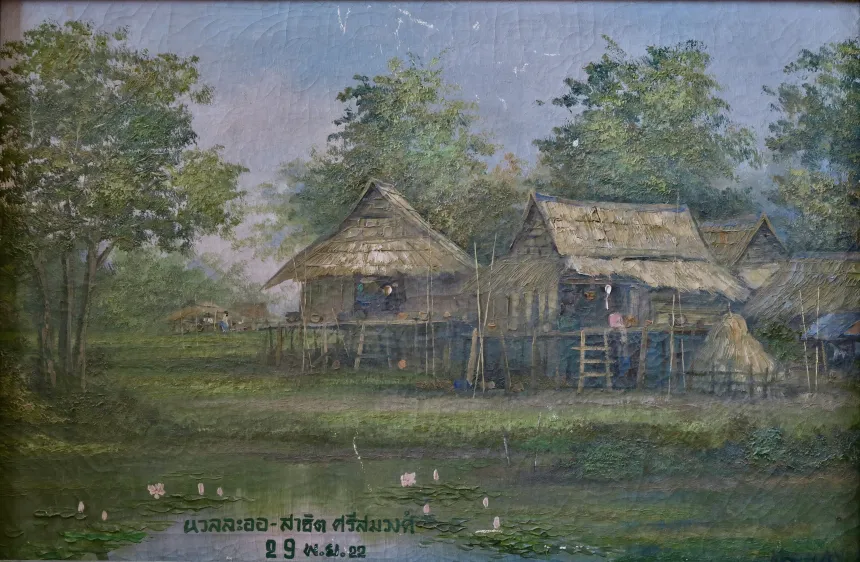I’ve always believed that art carries the soul of a place, a moment frozen in time that whispers stories of its creator and their world. Living in Bangkok has deepened my appreciation for Thai culture, especially the quiet beauty of its rural life. So, when I stumbled upon this painting at “บ้านขายของเก่า” (House of Old Things) in Salaya, I knew I had to bring it home. It’s a 41x81cm piece by Thai artist Nogsuan, painted on November 29, 1979 (2522).

The painting depicts a tranquil scene of traditional Thai houses on stilts, their thatched roofs peeking through a lush canopy of trees. The foreground is dotted with patches of green, hinting at a canal that’s just out of sight. The colors are soft, almost dreamlike, with a weathered texture that gives it a sense of history. It’s framed in a rustic wooden frame that’s seen better days, but the wear only adds to its charm. There’s something deeply nostalgic about it: it reminds me of the floating markets I’ve visited in Ratchaburi, where life moves at the gentle pace of the water.
What drew me to this piece was the signature at the bottom, written in Thai: ๒๙ พ.ย. ๒๕๒๒ (“November 29, B.E. 2522”). A quick calculation told me that 2522 in the Buddhist calendar translates to 1979 in the Gregorian calendar, making this piece over four decades old. The shopkeeper handed me a tattered piece of paper with a biography of the artist, Nogsuan, which I later pieced together.
Also, the only text on the painting, apart of the signature on the bottom-right “Nogsuan”, is “นวลละออ - สาธิต ศรีสมวงค์” (Nuan La-or - Sathit Srisomwong). This could be the title of the painting or the name of the couple who lived in the house depicted, but I’m not sure.
Over time, I will need to bring it to a specialized art restorer to remove the dust and restore the original colors.
Artist Motivations
Nogsuan was born in Ratchaburi Province in 1941 and completed his secondary education in Damnoen Saduak District, where a nearby floating market is located. He studied at Poh-Chang Academy of Arts in Bangkok, graduating with a Diploma of Fine Art in 1962. After teaching art in his hometown, he traveled to Rome for an art study tour in 1974 and continued teaching afterward. His early exposure to canal life in Damnoen Saduak deeply influenced his artistic focus, with most of his works depicting people living by the canal. Nogsuan preferred painting with a palette knife, a technique that gives his pieces their distinctive subtle texture.
The painting captures the delicate and nostalgic essence of rural Thai life that Nogsuan sought to portray.
I paid a modest sum for it, though I won’t bore you with the haggling details. The painting now hangs in my home office, where it catches the attention just right, specially when I research for my AgriTech projects. Every time I look at it, I’m transported to those serene canals, imagining the lives of the people who once lived in those stilted houses.
It’s a small but meaningful addition to my collection, a reminder of how art can bridge cultures and eras.
For those curious about Nogsuan, his works are apparently well-regarded in Thailand, often displayed in first-class galleries in Bangkok. I might dig deeper into his portfolio, perhaps there’s another gem waiting to be discovered. Until then, this painting will keep whispering stories of a Thailand that feels both distant and familiar.